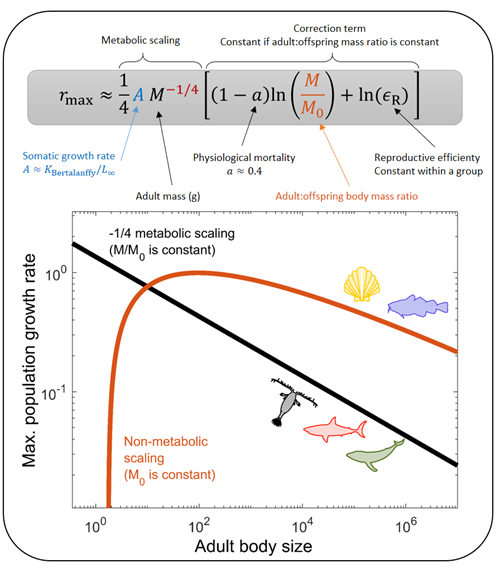The Metabolic Theory of Ecology states from scaling laws that population-level properties – maximum population growth rate—scales with a -1/4 exponent with size. However, this prediction rests on the assumption that adult and offspring size are proportional. We developed a new theory in The American Naturalist predicting maximum population growth rate from life histories traits. We show that groups with a constant offspring size do not obey the -1/4 prediction.
Background
Metabolism is a fundamental process of all living organisms. It describes the energy that an individual processes and allocates to physiological processes: maintenance, growth, and reproduction. Metabolism scales with body mass with a 3/4 exponent. The relationship between metabolism and body size implies that population-level properties, like maximum population growth (rmax), are also influenced by body size. rmax indicates the recovery rate of a population depleted to levels where density dependence does not limit population growth. While that condition is rare in nature, rmax is an essential parameter for conservation applications, such as wildlife and fisheries management, and understanding invasion potential.
From dimensional arguments, the Metabolic Theory of Ecology predicts that maximum population growth rate scales with a −1/4 exponent with body size (m). However, this argument implicitly assumes that offspring size is proportional to adult size. We estimate the rmax for any group from three traits: the adult mass, the somatic growth rate, and the adult:offspring mass ratio.
Results
We show that not all the groups obey the -1/4 scaling law. Groups with a constant adult:offspring mass – sharks, copepods, and marine mammals – follow the classic -1/4 scaling law. Conversely, groups employing a constant offspring strategy – teleost and bivalves – deviate from the traditional scaling law. Our work extends classic predictions from MTE by accounting for ontogeny and variation in life-history patterns. This work helps understand systematic differences among taxa, for instance, why sharks are more sensitive to exploitation than teleost. This approach is general and applies to all living organisms.

Links
Read the paper here: https://www.journals.uchicago.edu/doi/full/10.1086/718642
Test model: https://remydenechere-centreforoceanlife.shinyapps.io/rmax/